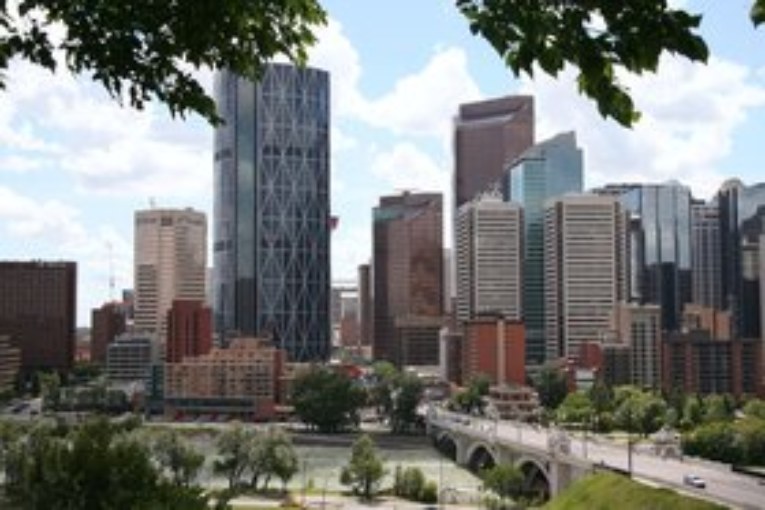
When the lease on an Alberta Health Services office in Calgary came due for renegotiation two years ago, the rental market was so bad that trying to keep the tenants wasn’t worth it.
Instead, landlord Strategic Group took the unconventional step of letting the government agency leave and spent C$24.5 million to convert the seven-story building into an apartment complex.
Aside from the renovation cost, the building sat vacant for almost a year. But those were risks the company had to take to cope with a market that’s been gutted by an exodus of oil-industry jobs.
“We’d still be losing money if they’d stayed,” Chief Executive Officer Riaz Mamdani said in an interview in a new apartment in the building, which has been re-branded as Cube.
“The cost of keeping them in this building was greater than the value of the building. That just made no economic sense.”
Developers in Canada’s oil capital are converting workplaces to homes as office vacancies hover near record highs after an exodus of international producers and industry-wide job cuts.
Following the 2014-2016 price crash, companies are grappling with a pipeline shortage that discourages growth. Encana Corp., Cenovus Energy Inc. and MEG Energy Corp. are among producers that have cut jobs in the past two years even as global crude prices rebounded.
The conversion trend is also taking root in Alberta’s capital of Edmonton, where new office towers have left older buildings without tenants, as well as in other cities where residents are eager to move downtown.
But nowhere are conversions as needed as in Calgary. Since 2016, more than 20% of the city’s downtown office space has been available for rent, according to commercial real estate analysis firm CoStar Group. That’s roughly five times the rate in Toronto and Vancouver, and about twice as much as Edmonton. By contrast, Calgary’s residential vacancy rate is 4.1%.
Empty office towers were unthinkable just five years ago, when the city long accustomed to being one of Canada’s richest was teeming with executives and workers from around the globe.
“This was the land of 1% vacancies when times were good,” said Roelof van Dijk, director of Canada market analytics at CoStar. Now, “Landlords are looking at ways to get around the high vacancy and figure out income streams.”
The city, suffering from declining property-tax revenue, is also doing its part. While inter-provincial trade agreements prevent cities in Alberta from offering tax incentives to lure corporate offices, city-funded Calgary Economic Development is on a full-court press to try to woo new businesses.
The group, with hundreds of active files mostly for companies with 50 to 60 employees, recently manged to draw BASF SE’s Canadian headquarters and its 60 workers to Calgary, away from Mississauga, Ontario. It also runs the Startup Calgary initiative to help entrepreneurs get businesses off the ground and manages a fund that invests in innovative projects.
But to undo the damage from the oil downturn, the city will need to attract major companies, and that will be its focus in the coming years, Calgary Economic Development CEO Mary Moran said.
“We have to deal with it like it’s a 10-to-15 year issue and have long-term commitments to the solutions,” she said.
That time horizon accords with Mamdani’s forecast that the city will need 12 to 16 years to absorb all of its vacant office space. With that in mind, he has embarked on other office-to-residential projects. The firm is turning the Barron Building, a historic office tower built in 1951 as the city went through its first oil boom, into 94 apartments for more than C$100 million. The edifice is scheduled to open to residents in 2020.
In Edmonton, Strategic Group is investing C$54.5 million to turn an office tower into 177 apartments in what it’s calling the e11even, and C$57 million to convert another building called Capital into 154 suites.
Other developers have embarked on similar projects.
In Edmonton, the former Enbridge Tower, which has a peaked roof that makes it one of the city’s most recognizable buildings, was converted to a 300-room hotel by Lighthouse Hospitality for about C$70 million.
The strategy has its limits, though. Office towers with large floor plans can’t be converted because the apartments, which need to stretch from the building’s exterior to the interior elevator corridor, would be impractically long. Also, the vacant offices are signs of struggling job markets, which limit residential demand. Calgary’s unemployment rate was 7% in May, compared with a 5.4% national average.
But Mamdani, 51, is confident in Calgary’s future. The city already has reduced its reliance on the boom-and-bust oil industry to about a third of its economy from roughly half in the 1990s. And even through the oil sector’s peaks and troughs, residential demand has grown, helped by international immigration and a relatively young population.
It’s those younger professionals that the Cube is aimed toward, Mamdani says. The apartments, which start at around C$1,300 per month, feature white quartz countertops, floor-to-ceiling windows, built-in safes, high ceilings and stainless steel appliances, along with wall USB charging ports and a rooftop firepit with mountain views.
Mamdani says those amenities and the apartments’ newness — about two-thirds of the city’s apartments are at least 40 years old — have helped residents overlook the quirks left over from the building’s previous life as an office tower, including some inconveniently placed pillars, along with a few awkward hallways and unconventional floor plans. The building is already about half full even though some construction, mostly on the building’s exterior, has yet to be completed.
Mamdani is encouraged by those results, especially since Alberta Health Services didn’t vacate the premises until the end of August, meaning the whole turnaround has taken less than a year. City bureaucrats were willing to do “backflips” to speed the project along, he said.
“Everyone is on-side with something that’s this good for the city.”
© 2019 Bloomberg L.P.
You can read more of the news on source
